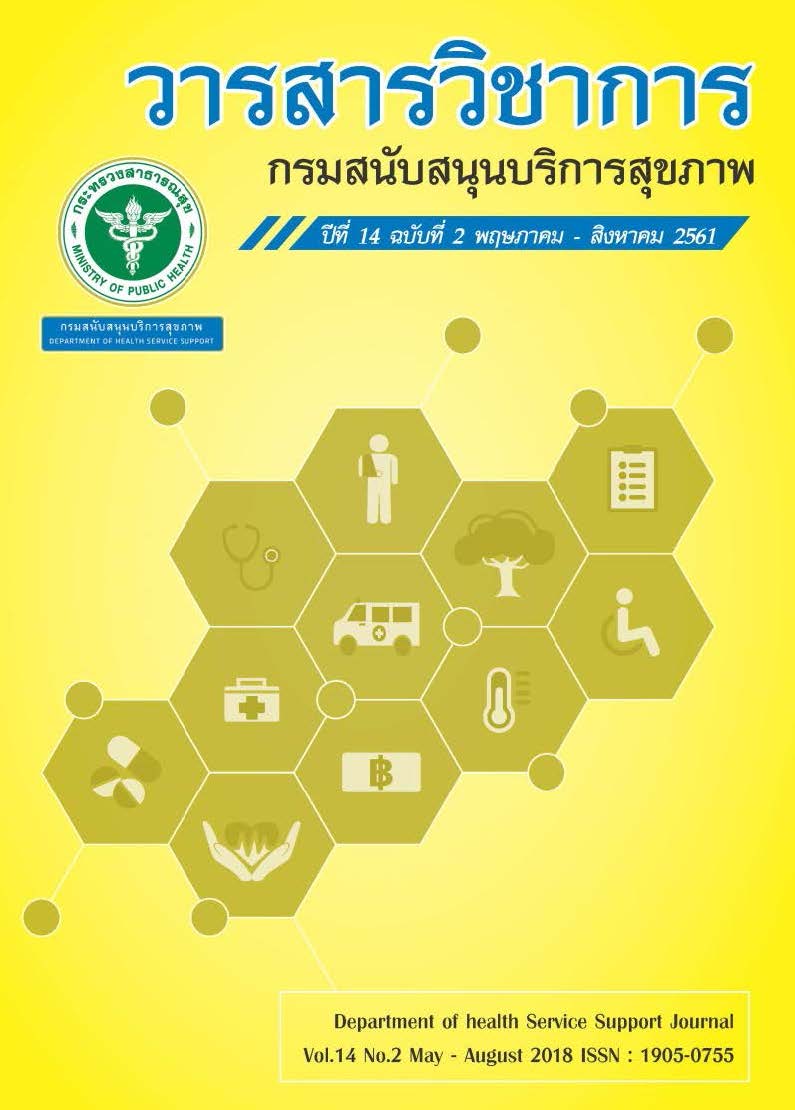หลักเกณฑ์การปรับระดับศักยภาพหน่วยบริการสุขภาพในมุมมองผู้ปฏิบัติงาน
Keywords:
Primary Care, Secondary Care, Tertiary Care, Community HospitalAbstract
The objective of this practical research is to study criteria for Potential improvement of Health service. The sample population consists of 35 citizens, specifically selected from Health service, Primary care, Secondary care, and Tertiary care center during March, 2016 to December 30, 2017. Structural Interview and Focus group are used as Study tools. As a result, it is shown that
- An upgraded criteria from Primary care (Level S) to Tertiary care (Level A) should be constructed as followed;
1) Policy or Strategy used for Service system improvement in Area Health
2) Emphasizing on an improvement of experts and Academic center
3) Being the Potential leader (Level 1) of Expert center at least 2 areas
4) Proposing for value assessment before upgrade
- There are 2 ways to upgrade criteria from Primary care (Level S) to Secondary care that are Level M1 or Level S. In order to upgrade Community Hospital (Level M2) to Secondary Care (Level M1 or Level S), it should refer to following procedure;
1) Number of OPD (Out-Patient-Department)
2) Number of IPD (In-Patient-Department)
3) Financial condition of the Hospital
4) Potential criteria of IPD (CMI)
- An upgraded criteria from Primary Care (Level F1) to Community Hospital (Level M2) should refer to following procedure;
1) Population standard
2) Population Transfer
3) Number of OPD
4) Number of IPD
5) Cesarean section should be clearly identified
6) Risk score for Financial risk, no more than Level 3
7) Potential assessment for Hospital such as CMI, SumAdj RW, and Active Bed
An upgraded criteria from Small Primary Care (Level F3) to Primary Care (Level F2) should refer to Basic needs depending on Area and Environmental difference such as Location/Area size and Distance, including Potential assessment for Hospital such as CMI, SumAdj RW, and Active Bed
For implementation, Every Level of Health service under Office of the Permanent Secretary can apply this criteria resulting from “Practical Criteria for Potential upgrade of Health Service” in order to assess the readiness or to analyze the lacking factors that’s obscure the upgraded Potential.
References
Health Administration. (2017). Division. Operations and Service Plan 2560-2564. The Publisher of Thailand Agricultural Cooperative.
Hong-aumpai, P. (1992) The factor analysis of Health-Care Service’s budget allocation: A Case Study of the Office of the Permanence Secretary Ministry of Public Health. Master of Economic Thesis, Chulalongkorn University.
Na Ranong, V. and Committee. (2002). Follow up and Project Assessment “30 Baht Health care scheme. Ministry of Public Health. Thailand Development Research Institute (TDRI).
Pattamasiriwatt, D. and Committee. (2007). Potential Budget Management for Health Service, Case study of Secondary and Tertiary care 95 units under Office of the Permanent Secretary. Journal of Economic Publish, Thammasart University. 25(4).
Saensantier, K. and Jangkloi, U. (2016). Cost and budget analysis of health-care right for Community Hospital in Nakhonratchasima. Province the Management Journal, 11(1).
Sararatch A., Hanucharoenkul S., and Vittayasuppakorn J. (1999). The study on Potential of Hospital Center and Specialized Hospital in order to be a training center for several Medical Branch. Thai Journal of Nursing, 14(1).
Strategy and Planning Division. (2016). Thailand Public Health 2011-2015. Bangkok: The Publisher of Thailand Under Royal Patronage of His Majesty the King.
Downloads
Published
How to Cite
Issue
Section
License
Copyright (c) 2019 Journal of Department of Health Service Support-วารสารวิชาการกรมสนับสนุนบริการสุขภาพ

This work is licensed under a Creative Commons Attribution-NonCommercial-NoDerivatives 4.0 International License.



